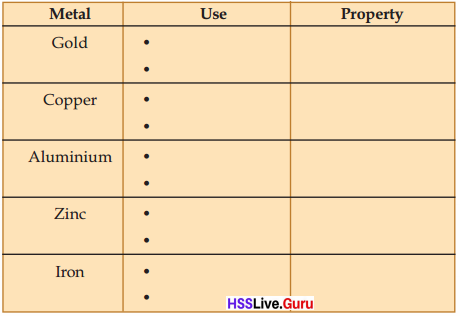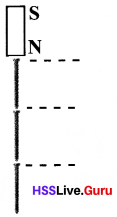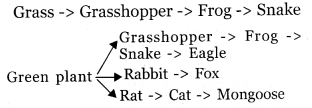You can Download Basic Constituents of Matter Questions and Answers, Summary, Activity, Notes, Kerala Syllabus 8th Standard Basic Science Solutions Chapter 5 help you to revise complete Syllabus and score more marks in your examinations.
Kerala State Syllabus 8th Standard Basic Science Solutions Chapter 5 Basic Constituents of Matter
Basic Constituents of Matter Questions and Answers
The particles in sugar candy and potassium permanganate solutions cannot be seen as they are extremely small. If we take one or two pieces of camphor in a china dish and heat the china dish. Even though the camphor has disappeared completely, the smell of camphor remains in air. This is because the camphor has spread in air as extremely small particles.
Fill one quarter of a boiling tube with sugar and close it with cotton. Then heat the boiling tube strongly. The water in sugar is sticked on the sides of the boiling tube as water vapour. Carbon and water are the components of sugar. Water can be further divided. When electricity is passed through water it splits into hydrogen and oxygen. That is sugar, a pure substance, can be divided into carbon, hydrogen, and oxygen. At the same time, pure substances like carbon, hydrogen, oxygen, gold, and silver cannot be further divided into its components by chemical reactions.
Basic Constituents Of Matter Class 8 Kerala Syllabus Elements and Compounds
The pure substances which cannot be further decomposed through chemical processes are called elements.
Ex: hydrogen, oxygen, gold, silver Compounds are pure substances formed from two or more elements through chemical combination.
Ex : water, sugar, carbon dioxide
Origin of the names of elements
In the past, the elements were named after places, countries, continents, characteristic properties, scientists, planets, satellite etc.
Ex : Place – polonium, francium
Continent – Europium, Americium
Character, colour – rubedium, chromium
Scientist – bohrium, curium
Planet – neptunium
Basic Constituents Of Matter Class 8 Questions And Answers Kerala Syllabus Symbols
The first letter of the English or latin letters are used as the symbols of the ele-ments.
Ex: Carbon – C
Oxygen – O
Sodium-Natrium – Na
Potassium-Kalium – K
But, for some elements, along with the first letter, the second or another prominent letter is also used in the symbol as a small letter.
Ex: Calcium – Ca
Chlorine – Cl
Basic Constituents Of Matter Class 8 Notes Pdf Kerala Syllabus Atom and Molecule
The element carbon is made up of extremely small particles. Think of breaking a piece of carbon into smaller and smaller particles. When it is broken up in this manner, we get the smallest particle which retains all the characteristic properties of carbon at the end. This smallest particle is called an atom of carbon.
Atoms of some gaseous elements like helium, neon etc., can exist as free single atoms. But atoms of some other gaseous elements like hydrogen, oxygen etc., can exist only as a combination of two atoms. Atoms of some elements are seen to exist as a combination of more than two atoms. The smallest particles which can exist independently are called molecules.
Method of representing Atoms and Molecules
The symbol of helium is ‘He’. When we write ‘He’, it represents one atom of the element helium. 2He means two helium atoms.
Elements like helium, neon, argon, etc., are seen in nature as single atoms. But elements like hydrogen exist as diatomic molecules. Hydrogen atom is represented as H. But H2 represents a hydrogen molecule.
Some elements exist as molecules of more than two atoms. Phosphorus (P4), sulphur (S8), etc., are examples of such
elements.
Molecules with only one atom are called monatomic molecules.
Ex: He, Na
Those with two atoms each are called diatomic molecules.
Eg: O2, H2, N2
The molecules with more than two atoms are called polyatomic molecules.
Eg: P4 S8
In monatomic molecules, the number given on the left side of the symbol indicates the number of molecules and atoms. In polyatomic molecules, the subscript on the right side of the symbol indicates the number of atoms within one molecule. The total number of molecules is indicated on the left side.
O – One oxygen atom
O2– One oxygen molecule
2O2 – Two oxygen molecules
2He – Two helium atom/molecule
5Na – five sodium atoms
Basic Constituents Of Matter Kerala Syllabus Compounds
We have seen how molecules are formed from the same type of atoms. Similarly, the compounds contain molecules formed from atoms of different elements.
Carbon dioxide molecule is formed when one carbon atom combines with one oxygen atom.
This is a compound. Water is a compound formed by the combination of hydrogen and oxygen.
Carbon dioxide is formed when carbon burns in oxygen. Carbon dioxide is also formed by the decomposition of calcium carbonate. Whatever be the sourcj of a compound, a fixed ratio is maintained between the atoms of the different elements present in it. In carbon dioxide molecule, the ratio of carbon atoms to oxygen atoms is always 1: 2. Thus carbon dioxide molecule can be represented as CO2. Similarly in water molecule the ratio of hydrogen and oxygen atom is 2:1 This type of representation is known as the chemical formula of the compound.
H2SO4 ,CO2 ,H2O, HCl, NaCl
2CO2 represents two carbondioxide molecules. We can understand that there are 6 atoms including 2 carbon atoms and 4 oxygen atoms in 2CO2.
There are 7 atoms including 2 hydrogen atoms, 1 sulphur atom and 4 oxygen atoms in H2 SO4, Molecule. There will be 14 atoms in 2H2 SO4
Basic Constituents Of Matter Notes Kerala Syllabus Chemical Equations
The chemical equation of the reaction between zinc and hydrochloric acid forming zinc chloride and hydrogen is written as shown below.
Zn+HCl → ZnCl2 + H2
Here Zn and HCl are reactants. ZnCl2 and H2 are products.
The chemical reactions can be represented as equations containing the symbols and chemical formulae of the reacta¬nts and the products. When a chemical equation is written, the number of atoms of the same kind, on the side of reactants and that of products should be equal. That is the chemical equation given above is to be rewrite as
Zn + 2 HCl → ZnCl2 + H2
Now the number of atoms in both side of the arrow is equal. This type of chemical equations which is written such that the number of atoms of same type is equal in the side of reactants and products are called balanced chemical equations.
Basic Constituents of Matter Textbook Questions and Answers
Basic Science Class 8 Chapter 5 Kerala Syllabus Question 1.
Classify the following into elements and compounds. Ammonia, sugar, nitrogen, mercury, sodium chloride, water, copper sulphate, sodium, carbon.
Answe:
| Elements | Compounds |
| Mercury | Ammonia |
| Sodium | Sugar |
| Carbon | Sodium chloride |
| Nitrogen | Water |
| Copper sulphate |
Hsslive Guru 8th Class Chemistry Kerala Syllabus Question 2.
Analyse the chemical equation given for the reaction between nitrogen and hydrogen to give ammonia.
N2+3H2 → 2NH3
a. What are the reactants and products in this reaction?
b. Find the total number of molecules and atoms of the reactants.
c. Find the total number of molecules and atoms of the products.
d. What is the relation between the number of atoms of the reactants and products?
Answer:
a. Reactants: nitrogen, hydrogen Product: ammonia (NH3)
b. Total number of molecules in reactant – 4 total atoms- 8
c. Total number of molecules in product -2 total atoms- 8
d. Total number of atoms in reactants and products are equal.
Hsslive Guru Chemistry 8 Kerala Syllabus Question 3.
N is the symbol of nitrogen.
a. What do N2, 2N and 2N2 indicate?
b. How many molecules and atoms are present in 5N2?
Answer:
a. N2 – One nitrogen molecule
2N – Two nitrogen atoms
2N2 – Two nitrogen molecules
b. 5N2 – 10 atoms, 5 molecules
Hss Live Guru 8th Chemistry Kerala Syllabus Question 4.
Some chemical equations are given.
C + O2 → CO2
CH4 + 2O2 → CO2 + 2H2O
N2 + O2 → NO
CaCO3 → CaO + CO2
H2 + I2 → HI
Fe + HCl → FeCl2 + H2
CO2 + C → CO
a. Which of these are balanced chemical equations?
b. Balance those equations which are not balanced.
Answer:
a. C + O2 → CO2
CH4 + 2O2 → CO2 + 2H2O
CaCO3 → CaO + CO2
b. N2 + O2 → 2NO
H2 + I2 → 2Hl
Fe + HCl → FeCl2 + H2
CO2 + C → 2CO
Basic Science Class 8 Solutions Kerala Syllabus Question 5.
Find whether the following statements are right or wrong.
a. All atoms of the same element show the same properties.
b. The atoms present in a compound are different.
c. Elements are pure substances.
d. Hydrogen is a monatomic molecule
Answer:
a. True
b. True
c. True
d. False
Matter And Chemical Formula Class 7 Kerala Syllabus Question 6.
Take iron powder and sulphur powder in their mass ratio of 7:4 in a china dish. Heat it strongly for some time.
a. Try to separate the iron powder using a magnet. What can be observed? What is the reason?
b. Add a .little dilute hydrochloric acid to the above product; observe the changes taking place, and write them down.
c. Write down the inferences you have arrived at from these observations.
Answer:
Sulphur is reacted with iron powder to form ferrous sulphide therefore it cannot be separated.
There will be the smell of rotten egg because hydrogen sulphide is produced.
8th Class Chemistry State Syllabus Kerala Syllabus Question 7.
Make and exhibit the models of the following molecules using ball and sticks, different fruits and splints.
a. Water (H2O)
b. Ammonia (NH3)
c. Carbon dioxide (CO2)
d. Methane (CH4)
Answer:
Do your self
Basic Science Class 8 Pdf Notes Kerala Syllabus Question 8.
Haven’t you understood how symbols are assigned to elements? Given below are some elements that received symbols from their Latin names. Complete the table with the help of the Periodic Table.
| Element | Latin name | Symbol |
| Silver | …………….. | …………….. |
| …………….. | Hydrargium | …………….. |
| Tin | …………….. | …………….. |
| …………….. | …………….. | Pb |
| Antimony | …………….. | …………….. |
| …………….. | Aurum | …………….. |
Answer:
| Element | Latin name | Svmbol |
| Silver | Arguntum | Ag |
| Mercury | Hydrargium | Hg |
| Tin | Stannum | Sn |
| Lead | Plumbum | Pb |
| Antimony | Stibium | Sb |
| Gold | Aurum | Au |
Basic Constituents of Matter Additional Questions and Answers
Basic Science Question Answer Chapter Wise Class 8 Kerala Syllabus Question 1.
Choose the correct symbol of the elements given below from the box.
(Calcium, carbon, sodium, potassium, Iron, silver)
(S, C, Na, Ca, Si, Ag, In, P, K, Fe)
Answer:
Calcium-Ca,
Carbon-C,
Sodium- Na,
Potassium- K,
Iron- Fe,
Silver- Ag
Basic Science For Class 8 Chapter 5 Kerala Syllabus Question 2.
The chemical formula of calcium bisulphate is Ca (HSO4)2. Write down the number of atoms of each element present in this molecule.
Answer:
Ca=1, H=2, S=2, 0=8
Basic Science Class 8 Kerala Syllabus Question 3.
Na. This is the symbol of an element. Which statement given below is wrong. Justify?
- Symbol of Nitrogen
- Indicates one atom.
Answer:
Symbol of Nitrogen.
The symbol that represent the element Nitrogen is ‘N’. ‘Na’ is the symbol of sodium.
8th Class Chemistry Notes Pdf Kerala Syllabus Question 4.
We know about elements and compounds. Find out the odd one from the following. Give reason?
a. (A) Hydrogen (B) Oxygen (C)Nitrogen (D) Carbon dioxide
b. (A) Sodium (Na), (B) Pottasium (K) (C) Magnesium (Mg), (D) Iron (Fe)
c. Write the molecular formula of carbon dioxide?
d. What is the Latin name of sodium?
Answer:
a. Carbon dioxide – Compound, others are elements.
b. Magnesium – Others take symbols from their Latin name.
c. CO2
d. Natrium
8th Std Basic Science Textbook Kerala Syllabus Question 5.
Arrange the following from smallest to largest.

Answer:
Atom → Molecule → Small particle → Substances
Physics Class 8 Kerala Syllabus Question 6.
Represent the basis of nomenclature of elements given in the following table.
a.
| Element | Basis of nomenclature |
| Francium Rutherfordium | |
b. Which element symbol is Cl?
c. What are the constitute elements containing of CaF2 molecule?
Answer:
a. Name of country
b. Name of scientist
c. Chlorine
d. Calcium, -Fluorine
Question 7.
Symbol of Nitrogen is ‘N’.
a. What represent symbols of 2N and N2?
b. How many atoms are in 2NH3?
c. How can represent 5 water molecules?
Answer:
a. 2N represent 2 atoms of Nftrogen. N2 represent Nitrogen molecules can be formed by combining two atoms of Nitrogen.
b. 8 atoms
c. 5 H2O
Question 8.
Evaluate the given chemical equation and answer the following questions.
SO2 + O2 – SO3
a. Which are the reactants in the chemical reaction?
b. What is the product of the chemical reaction?
c. Write the balanced chemical equation?
Answer:
a. SO2, O2
b. SO3
c. 2SO2 + O2 → 2SO3
Question 9.
Find the monoatomic molecule from given elements.
a. (A) Hydrogen (B) Oxygen (C)Nitrogen (D) Helium
b. Write the symbols of Hydrogen and Helium?
c. Write chemical formula of Oxygen molecule?
d. What is the Latin name of sodium?
Answer:
a. (D) Helium
b. Hydrogen (H), Helium (He)
c. O
d. Natrium
Question 10.
Select the compounds from the following:
HCl, CO2, O2, NaCl, H2, H2O, Na, HCl
Answer:
NaCl, CO2, H2O, HCl
Question 11.
Form a table of elements which are related to the name of scientists from the following Americum, Mentelivium, Titanium, Rutherfordium, Rubedium, Einstenium, Europeum, Bohrium
Answer:
Mentelivium, Rutherfordium, Einstenium, Bohrium
Question 12.
Examine the following symbols and write the name of elements Ca, Cr, Cl, Be, Na, Fe, Cu
Answer:
Calcium, Chromium, Chlorine, Berelium, Sodium, Iron, Copper
Question 13.
Fill in Blanks suitably
Element – Atom,
Compound – …………
Answer:
Element – Atom,
Compound – Molecule
Question 14.
Complete the following table
| Element | Basis of Naming |
| Americum | |
| Francium | |
| Rubedium | |
| Plutonium | |
| Titanium | |
| Mentalivium | |
| Rutherfordium | |
Answer:
| Element | Basis of Naming |
| Americum | America- continent |
| Francium | France – country |
| Rubedium | Ruby – Colour |
| Plutonium | Pluto- planet |
| Titanium | Titan – God |
| Mentalivium | Mentelief – Scientist |
| Rutherfordium | Rutherford – Scientist |
Question 15.
Examine the following molecules and tabulate the atoms contained in them.
1. Carbon dioxide
2. hydrogen chloride
3. Water
4. sugar
5. Mercuric oxide
Answer:
1. C, O;
2. H, Cl
3- H, O;
4. H, C, O;
5- Hg, 0
Question 16.
Complete the tables
| Element | English name | Symbol |
| Carbon | Carbon | C |
| Oxygen | …………. | …………. |
| …………. | Nitrogen | …………. |
| …………. | …………. | H |
Answer:
| Element | English name | Symbol |
| Carbon | Carbon | C |
| Oxygen | Oxygen | 0 |
| Nitrogen | Nitrogen | N |
| Hydrogen | Hydrogen | H |
Question 17.
Tabulate the number of atoms and molecules
5H2, 2H2 O, 3ZnCl2, CO2
Answer:
| Compound | Number of atoms | Number of molecules |
| 5H2 | 10 | 5 |
| 2H20 | 6 | 2 |
| 3ZnCl2 | 9 | 3 |
| co2 | 3 | 1 |
| co2 | 3 | 1 |
Question 18.
Write the diatomic molecules from the following
H2, Na, C, N2, P4, O2
Answer:
H2, N2, O2
Question 19.
Complete the table
| Monatomic | Diatomic | Polyatomic |
| ……….. | H2 | P4 |
| Na | ……….. | ……….. |
| He | ……….. | ……….. |
Answer:
| Monatomic | Diatomic | Polyatomic |
| C | H2 | P4 |
| Na | O2 | O3 |
| Ne | N2 | S8 |
| He | Cl2 | |
Question 20.
How many hydrogen and sulphur atoms are there in H2SO4 molecule?
Answer:
Hydrogen-2 Sulphar-1
Question 21.
Complete the table.
| Substance | No. Of molecules | No. of atoms |
| P4 | | |
| 02 | | |
| 5Na | | |
| 2Na | | |
| 6Cl2 | | |
| 2He | | |
Answer:
| Substance | No. Of molecules | No. of atoms |
| P4 | 1 | 4 |
| 02 | 1 | 2 |
| 5Na | 5 | 5 |
| 2Na | 2 | 2 |
| 6Cl2 | 6 | 12 |
| 2He | 2 | 2 |
Question 22.
Find the total number of atoms in the following molecules
a. CO
b. 5 H2O
c. 7 NH3
d. 2 Cl2 H22 O11
e. 3 NaCl
f. ZnCl2
Answer:
a. CO – 2
b. 5 H2O -15;
c. 7 NH3 – 28;
d. 2C2 H22 O11 – 90
e. 3 NaCl – 6
f. ZnCl2 – 3
Question 23.
The chemical formula of water is H2O. Write the ratio of hydrogen and oxygen atoms in water molecule.
Answer:
Ratio of hydrogen and oxygen is 2:1
Question 24.
Tabulate the reactants and products in the following chemical equation.
1. 2H2 + O2 → 2H2O
2. Na + Cl2 → 2NaCl
3. C + O2 → CO2
4. H2 +Cl2 → 2HCl
Answer:

Question 25.
Balance the following equations which are not balanced.
C + O2 → CO2
H2 + N2 → NH3
Mg + O2 → Mgo
2H2 + O2 → 2H2O
Answer:
3 H2 + N2 → 2NH3
2Mg+O2 → 2MgO
Question 26.
How did the symbol system introduced by Berzelius, help the study of chemistry?
Answer:
- The study of chemistry became simple and easy.
- Writing chemical equations representing chemical reactions became very easy.
- The number of atoms in a molecule can be found out from the symbol of the molecule of the element.
Question 27.
Balance the equation
1. NaOH + H2 SO4 → Na2 SO4 + H2O
2. H2O2 → H2O + O2
3. CH4 + O2 → CO2 + H2O
4. NaOH + HCl → NaCl + H2O
5. H2O + CO2 → C6H12O6 + O2
Answer:
2NaOH + H2SO4 → Na2SO4 + 2H2O
2H2 O2 → 2HO2 + O2
CH4 +O2 → CO2 + 2H2O
2NaOH + 2HCl → 2NaCl + 2H2O
6 H2O + 6CO2 → C6 H12 + 6 O2





![]()
![]()











































































































